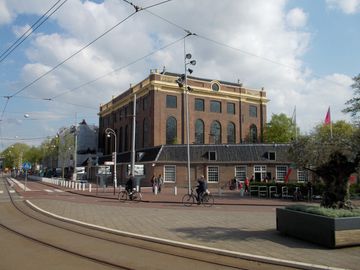

Here is yet again another testament to Amsterdam historical multi-cultural tolerance. Kahal Kados Talmud Torah, the Portuguese-Israelite Municipality of Amsterdam, is the oldest Jewish community in the Netherlands. It was founded in 1639 by the Portuguese Jews who fled Antwerp when the latter fell to the Spanish at the end of the sixteenth century. These Jews had already been expelled from Spain in 1492 by Alhambra Decree and first fled to Portugal. Those who fled to Portugal were nevertheless forcibly baptized in 1496. The ones who wanted to continue practicing their religion openly thus left Portugal for Antwerp, then the biggest city in the Netherlands, to escape the Inquisition. At last, Sephardic Jews found a safe haven in the tolerant Amsterdam. At that time the Dutch Republic was at war with Spain, so to avoid being identified with the Spanish enemy these refugees from the Iberian peninsula called themselves Portuguese Jews. Within a short time, three Sephardic communities sprung up in Amsterdam. In April 1639 all three were merged to form Talmud Torah, or the so-called Portuguese-Jewish Congregation. The community used Portuguese for scientific work, while poetry and prose were written in Spanish. In the early years the rabbis allowed a part of worship to be carried out in Portuguese so as to facilitate the return of the former converts, or Marranos or Conversos as they were called, to their original fate. Only when the Hebrew congregation grew powerful enough was the service going to be held entirely in Hebrew. Service announcements are done in Portuguese to this day. In the first decades, the rabbis were mainly employed from Italy and sometimes from Salonika and Morocco. Amsterdam became a center of Jewish learning and scholarship. The seminary still possesses one of the most important Jewish libraries in the world. The prominence and wealth of the Portuguese Jews found its ultimate expression in the Esnoga, which together with the synagogue in Prague, is the oldest functioning synagogue in the world. Construction of the Esnoga began in 1671 on what was then the edge of the city. Designed by the architect Elias Bouwman, it was built in the classical style which was popular with the Amsterdam elite at the time. The building is free-standing and rests on wooden piles. The foundation vaults can be viewed by boat from the water underneath the synagogue. The entrance to the main synagogue is inside the courtyard enclosed by a row of buildings housing the winter synagogue, offices and archives, homes of various officials, the rabbinate, a mortuary, and the famous EtzHayim library. The interior of the synagogue is a single very high rectangular space containing the community's original wooden benches used in the first synagogue and dating back to 1639. The floor is covered with fine sand, in the old Dutch tradition, to absorb dust, moisture and dirt from shoes and to muffle the noise. The Amsterdam synagogue inspired a number of sister temples in New Amsterdam - later New York - London and Curacao. It was from this synagogue community that Baruch Spinoza was expelled for his writings and to which he chose never to return despite the fact that initially he was offered to repent. During the 17th century large numbers of Ashkenazi Jews arrived from Central and Eastern Europe, and the Jewish community grew to be affluent and active in all aspects of the city life. In the centuries to come the community produced rabbis, scholars, philosophers, artists, architects, bankers, founders and trustees of major international commercial companies, as well as several city fathers and mayors. The war and the Holocaust dealt a severe blow to the community. Of the 140,000 Dutch Jews, 120,000 of whom lived in Amsterdam, only about 20,000 survived. Of the 4,300 Portuguese or Sephardic Jews, 3700 were murdered. Yet the Esnoga, for reasons unknown to this day, miraculously survived destruction by the Nazis; and four days after the liberation, on the 9th of May 1945, the first post-war service was held within its walls. A number of families saved Esnoga's sacred treasures from being destroyed through the war years.